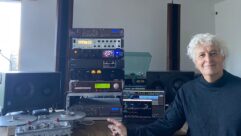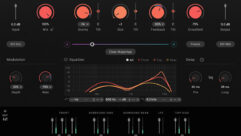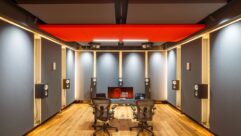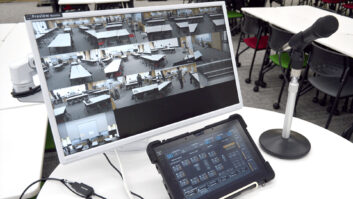Multichannel film today
Feb 1, 2000 12:00 PM,
Michael Karagosian
Whether residential or commercial, a detailed look at the modern cinema’svarious digital audio formats will lend depth to your theater installations.
Multichannel sound in the cinema has its roots in the 1939 release ofDisney’s Fantasia. “Fantasound,” as it was called, used three opticallyrecorded discrete sound tracks – left, center and right – with a fourthcontrol track for synchronization. The format used clever means to routeaudio to as many as 100 loudspeakers all around the auditorium. Theinherent complexity and World War II contributed to the demise of thesystem, and Fantasia was the sole release using this format. It was notuntil the 1950s, when a process for placing magnetic stripes on both 35 mmand 70 mm film was developed, that magnetically recorded multichannelsound-on-film was born. During that time, the Cinemascope sound format fromTwentieth Century Fox was introduced, which placed four channels ofmagnetically recorded audio on film – left, center, right, surround – andTodd-AO introduced the six-track format for 70 mm films – left, left extra,center, right extra, right and surround.
No improvements were made to that arrangement until the 1970s when DolbyLaboratories introduced two new concepts to film sound. One was theimplementation of noise reduction in both magnetic and optical tracks. Thesecond was the introduction of quadraphonic matrixed audio to stereooptical recordings. By adding noise reduction to magnetic tracks, Dolbyincreased the dynamic range of the medium and was able to enforce astandard flux level for on-film recording, further enhancing their abilityto control the quality of magnetic recordings. After making a few movieswith noise reduction added to the Todd-AO 70 mm format, Dolby decided touse the left extra (LE) and right extra (RE) loudspeakers as extended basstracks only and not as full-bandwidth sound tracks. Thus, the discretesubwoofer track was born, often referred to today as the LFE track (lowfrequency effects). This move caused the 70 mm sound format to beeffectively reduced to four-channels plus subwoofer. In 1979, Dolbyimproved the 70 mm format by adding stereo surround with the release ofApocalypse Now. The stereo surround process placed the upper frequencies ofthe stereo surround channels on the LE and RE channels and added the basssignal from the mono surround track to form full-bandwidth stereo surroundsignals. This format enjoyed few releases, however, because the popularityof 70 mm film waned. It was, however, the first step toward today’s popular5.1 format, having left, center, right, left surround, right surround andsubwoofer channels. Some large installations added the full-bandwidth monosurround to the rear of the theater, which was an early step towardthree-channel surround. (Michael Todd of Todd-AO also described athree-channel surround system in the 1950s.)
As high in quality as it can be, magnetic recording on film was andcontinues to be expensive. For this reason, Dolby’s other process, matrixedaudio for stereo optical recordings, was heralded as a major breakthroughin low-cost, multichannel audio for film. In the studio, a matrix encoderreduces four discrete channels to two. In the cinema, a matrix decoderderives left, center, right and surround signals from the stereo opticalsound track. Matrixed audio, however, has several drawbacks. The formatsupports only a mono surround signal, and the matrix process itself is notvery true to the original discrete four-track recording. In its struggle toget it right, Dolby implemented several matrix encode/decode processes inthe early years of the format and settled on a combination of technologiescalled variable matrix decoding and equal sound power. In the variablematrix scheme, a different decoding matrix is switched into the listeningpath based on the dominance of either left, center, right or surroundsignals. Each decoding matrix is designed to maintain sound power in thelistening environment; when it is steering, the matrix decoder has theleast perceptible effect on the total energy in the sound field.
Creating four tracks from two leaves a lot to be desired. When the centerchannel is dominant, a condition that occurs whenever dialog is present,the left and right channels become monophonic. The same occurs wheneversurround is dominant. Panning or any placement of sound other than a hardpan to a loudspeaker becomes tricky. To work around these flaws, a specialmonitoring device is used that allows the mixers to actually hear their mixbecause it will be heard in the cinema while they are mixing. Film mixerswho have worked extensively with the process will tell you of the manytricks that they have to use to obtain normal-sounding results when mixingfor the matrix.
In the late 1970s, Dolby Laboratories introduced another element into thefilm world that largely goes unrecognized, and that is the advent of thestand-alone cinema sound processor. To make the new sophisticated formatssimple to install, it became necessary for Dolby to sell a single productthat contained stereo optical photo-cell preamplification, noise reduction,matrix decoder, equalization, format selection and a single volume controlfor all channels. Thus, the cinema processor came into existence. Toaccommodate new and legacy formats, the cinema processor concept continuesto be the mainstay of the industry. Today, the manufacturing base haswidened considerably, and we also find quality cinema processor products onthe market from Sony, Ultra Stereo and Smart Devices.
Along comes digital audio
In 1990, the Optical Radiation Corporation, in collaboration with theEastman Kodak Company, introduced the world’s first digital audio formatfor film. Cinema Digital Sound (CDS) was first introduced to the publicwith the 70 mm release of Dick Tracy. Unfortunately, it enjoyed only ahandful of releases before ORC pulled the format from the marketplace. CDSwas a highly engineered technology (see Figure 1), incorporating an errordetection and correction scheme in the printed bitmap to ensure robustnessof the digital signal. The bitmap itself was impressive. Thanks to thesupport of Eastman Kodak and specially developed film stock, the formatboasted a tiny pixel size, giving the format lots of digital bandwidth onthe film. Audio was recorded without data compression, but instead of thecommonly used 16 bit linear PCM scale, it used a custom 12 bit logarithmicscale that produced excellent sound with a 90 dB dynamic range. Despite itsclever engineering, CDS suffered from a major shortcoming – the actualrecorded digital sound track for 35 mm films was placed where the stereooptical track normally resides. In other words, there was not a stereooptical track that could be used as a backup. CDS also suffered fromplayback equipment problems, which, combined with the absence of a backuptrack, turned the major filmmakers away from the format.
Optical Radiation’s CDS format should be remembered as the pioneer fortoday’s digital film sound formats. ORC was the first to introduce digitalaudio to the theater and the first to implement a discrete version oftoday’s popular 5.1 technique in a major exhibition format. The impact ofthe 5.1 format has been tremendous. From an artistic point-of-view,discrete digital sound has been a real boon because it frees the mixersfrom the limitations and hassle of mixing audio for the matrix. Full-rangeand discrete surround channels have given the mixers the ability to usethese channels much more freely. If one were to listen to the mixes oftoday and those of 10 years ago, the degree of artistic freedom that thedigital formats offer will be readily apparent.
Although it was announced in late 1990, it was not until 1992 when DolbyLaboratories first introduced the SR/D format, known today as DolbyDigital, with the release of Batman Returns. The development that made thisformat possible was the AC3 audio data compression algorithm for 5.1 audiosignals. Not wanting to repeat the mistakes of CDS, Dolby took pains topreserve the analog stereo optical recording format on the film alongsidethe new digital recording. Real estate on film is precious, so they optedto record the bitmap between the sprocket holes. A precarious place forsensitive digital data, no doubt, but there it remains. Dolby also chose amuch larger pixel size than CDS (approximately 1.1 mm 1.1 mm) and chose touse a 48 kHz sample rate. Thus, the digital bandwidth available for SR/Dwas much lower than for CDS, and consequently, AC3 delivers a highlycompressed audio signal. The format was first named SR/D presumably toemphasize the fact that stereo optical using SR noise reduction remained onthe film. Dolby’s format does not employ error correction; the formatrelies on the matrixed stereo optical track as backup when digital decodingfailures occur, which can happen with film wear or even splices.
Other digital formats were soon to follow. Digital Theater Systemsintroduced the DTS digital 5.1 format in 1993 with the release of JurassicPark. DTS took a novel departure from both CDS and Dolby by placing audioon CD-ROMs in a proprietary format and recording only an analogsynchronization track on the film. The DTS process has proven to be arobust method for implementing digital audio on film. In the event of lossof sync, DTS audio will free run for several seconds before switching overto a backup track. Once the time code track is valid, the processornoiselessly switches into the correct audio frame. On the film, the timecode track resides alongside the stereo optical track, so as with DolbyDigital, the format has the luxury of an analog backup track. On theCD-ROM, DTS uses a variation of the APT data compression algorithm,compressing 16 bit audio at a 44.1 kHz sample rate. DTS offers a fewvariations on its format. The commonly used exhibition format records fivechannels of audio, placing the subwoofer channel on the stereo surroundtracks below 80 Hz and thus, rolling up the stereo surrounds at 80 Hz. Adiscretely recorded six-channel version of the format is commonly used inspecial venue theaters.
The film industry is known for its competition and innovation, and Sony didnot want to limit its productions to a paltry 5.1 format. In 1993, Sonyintroduced the SDDS digital audio format with the dual releases of In TheLine of Fire and Last Action Hero. Unlike Dolby Digital and DTS, SDDS is a7.1 format, resurrecting the full range LE and RE loudspeakers of theTodd-AO 70 mm magnetic format days but now calling them left center andright center and combining them with discrete stereo surrounds and aseparate subwoofer track. As with Dolby Digital, the SDDS bitmap isrecorded directly on the film. Real estate on the film being ever morescarce; Sony engineers chose to place its bitmaps on both edges of the filmoutside of the sprocket holes. As with Dolby Digital, this is also aprecarious place for sensitive data. Unlike Dolby Digital, Sony chose toprint duplicate bitmaps on each edge of the film for redundancy. Thus, SDDSstrives hard to ensure a valid digital bit stream and is the only formatsince CDS to offer some method of error correction. As with the otherdigital formats, SDDS relies upon the stereo optical track for backup. SDDSuses a proprietary data compression scheme, reproducing 16 bit audio dataat a 44.1 kHz sample rate. SDDS uses a slightly smaller pixel size thanDolby, (approximately 0.9 mm 0.9 mm), and not having to dodge sprocketholes gives them plenty of bandwidth for a healthy, not-too-compressedeight channels of audio.
Not all SDDS releases, however, are recorded in the full 7.1 format.Historically, most releases have been recorded in a 5.1 format, and theleft center and right center (LC and RC) channels are largely unused, butit is possible for the Sony SDDS decoder to create artificial LC and RCchannels when needed. Conversely, for a film that is recorded in 7.1 formatbut played on a 5.1 system, the SDDS decoder will fold the LC and RCchannels into the left, center and right loudspeakers.
New formats continue, and in 1999, Dolby Laboratories introduced anextension to the 5.1 format by adding a center surround signal to the rearassembly of loudspeakers. Called the Surround EX format, there is nothingparticularly innovative about the technique; it uses the good old matrixencoder and decoder to place the additional track on the 5.1 stereosurround channel. In fact, carrying the idea further, it is possible to adda top-of-auditorium loudspeaker because of the capability of the matrixdecoder. (See Figure 3.) The EX format brings with it all of the hassle andlimitations previously experienced with stereo optical tracks but now withdigital stereo surround tracks. Although an extra channel certainly adds anew creative element for the film producer, the reintroduction of matrixmixing has not made EX the darling of Hollywood’s post-productioncommunity. It is interesting to note that Sony’s SDDS data format has thecapacity for three discrete surround channels, but Sony has not exploredthis as a product. In the words of Sony’s Dan Taylor, “We feel that the 7.1format has yet to be fully exploited.”
It is important to note that each of the existing digital formats occupiesan exclusive area of the film (see Figure 2). In practice, it is possibleand, in fact, increasingly common to release the film print with thebitmaps or time codes for more than one format. The question is often askedas to who will win the digital format war. The answer is everyone. Cinemais a creative industry, and film producers enjoy choice and innovation.There are limitations and advantages to each of the formats in terms ofsonic capabilities, distribution capability and the economics of the filmprint itself. As long as film is around, there will be a variety of formatsfor multichannel sound. Electronic cinema alters the multiplicity offormats. Having even more data space to play with, electronic cinema willonly increase the number of options available to the film producer.
The hardware
The earliest cinema processor offerings from Dolby Laboratories were theCP100 70 mm/35 mm processor and the smaller 35 mm-only CP50 processor. Overthe years, Dolby has released a variety of processors to replace theseproducts, including the CP200, CP65, CP55, CP45 and CP500. The CP200, firstintroduced in the early 1980s, was the first processor to support stereosurrounds. It has remained the choice of studios for its flexibilityalthough the unit is no longer in production. Among other brands, one canfind today a variety of 5.1 processors, including the Peavey CinemAcousticsCA-CP600, Sony DFP-3000 (also a 7.1 processor), Ultra Stereo JSX-1000 andSmart Devices MODV.
Decoding digital audio from film requires proprietary technology from thecompany that owns the technology. Dolby, for instance, offers the DA20decoder and an optical bitmap reader, which produce an analog 5.1 signalthat can be reproduced by any 5.1 cinema processor. DTS manufactures theDTS-6D, which plays the DTS CD-ROM discs and includes the optical time-codereader that mounts on the projector. The DTS-6D has not only the usualanalog 5.1 output, but also a digital output for direct digital connectionto a cinema processor. To date, only the CinemAcoustics CA-CP600 digitalcinema processor takes advantage of the DTS direct digital audio port.Until recently, Sony offered the DFP-D2000 and a corresponding opticalbitmap reader. The DFP-D2000 did not fit into the traditional cinemaprocessor mold by offering its own EQ, level control and bypass relays forpeaceful coexistence with a cinema processor. Ultra Stereo, however, offersa clever device that will allow the DFP-D2000 to be used as a source unitto traditional cinema processors. Sony has not announced a stand-alonedecoder replacement for this product. The block diagram of Figure 4 showsthe interconnection that could be required of a cinema processor if eachformat was installed at the same screen.
The most recent trend in cinema processors has been to include theproprietary digital processing in the cinema processors made by thecompanies that own the formats. Dolby Laboratories includes its DolbyDigital decoder in the CP500D. Sony includes its SDDS decoder in the newDFP-3000. DTS offers its DTS-6AD cinema processor, incorporating thecircuitry of the DTS-6D playback unit. None of these processors candirectly support the digital audio format of its competitors, meaning thatstand-alone decoders will continue to exist if each format is to gain thewidest possible number of installations.
Supporting multiple formats in the film world requires flexibleinstallations in the cinemas. In the cinema’s projection booth, it is notuncommon and, in fact, standard practice with many cinema chains to installfloating decoders, which are digital decoders or playback units that canroll about on carts and plug in to the cinema processor for any screen. Inmany cases, screens are not installed with a digital system and require afloating decoder if a digital feature is to be shown. As the marketsaturates, the sale of stand-alone decoders dwindles, but the use offloating decoders in the projection booth remains and is more widespreadthan most format providers acknowledge.
THX is a well-known but often misunderstood name in the cinema marketplace.It is commonly thought by the general public, and wrongly so, that theLucasfilm THX program incorporates its own sound format. In fact, the THXprogram is designed to create a system of standard theaters, all of whichmeet criteria produced by THX. In pursuit of its standard, THX approvesproducts for use in theaters, which, in turn, are licensed to use the THXname. THX also involves itself in the design of licensee theaterfacilities, observing isolation from neighboring screens, roomreverberation and even HVAC-related noise. THX performs a real and usefulservice to the listening public, but it does not produce a sound format.
System alignment
Dolby Laboratories first introduced the concept of “A” chain and “B” chainin describing its cinema systems to field technicians. A chain incorporatesthe sound source and related adjustments. B chain incorporates theloudspeaker EQ, level, crossover, amplification and the loudspeakersthemselves. Time has proven this to be a useful way of describing thecinema system. One can inject pink noise at a reference level into the Bchain and set up the listening level and EQ of the theater. In adjustingthe optical sound track playback, for instance, one can make the variouslevel and EQ adjustments required of the A chain without affecting thesettings for the B chain. Keeping the A chain and B chain adjustmentsseparate in the field technician’s mind is important for the correctalignment of a system.
The standard listening level for any full-range loudspeaker in a theater is85 dBc SPL. In the case of stereo surrounds, they are treated as a singlesurround source and individually adjusted for 82 dBc SPL. This level ismeasured using pink noise played at the reference RMS level of the cinemaprocessor. When Dolby noise reduction was introduced to the cinemaenvironment, the concept of reference level was easy to promote because itwas simply the “Dolby Level” required of the noise reduction. In thedigital environment, Dolby Level does not exist, but -20 dBFS (20 dB belowfull scale) is the point of reference commonly used by the various digitalformats.
One of the unique and interesting aspects of cinema sound is the X-curve.Curve X is described in ANSI PH22.202M-1984 / SMPTE 202M as ahigh-frequency rolloff for a typical 500-seat theater of 3 dB/octavebeginning at 2 kHz and 6 dB/octave at 10 kHz. Correction factors are givenfor other sizes of theaters, something that is largely overlooked in thisindustry. All cinema playback systems today are aligned to the X-curve. Thehistory of the X-curve begins with Dolby’s early attempts to promotefaithful reproduction of sound in theaters with fairly common and not toosophisticated measurement techniques. X-curve resulted from a study ofcinema acoustics across the country some 25 years ago. The frequencyresponse described by X-curve was designed to compensate for thereverberation and screen rolloff of the average theater, giving a uniformstatic frequency response to which all rooms are to be adjusted.
The problem with X-curve is that it is now 25 years old, and it isquestionable that the average theatre room acoustics found today are thesame as those when the standard was created. We have lost sight of the factthat the goal is to achieve a flat spectral response in the room afterenvironmental conditions such as room reverberation and air absorption aretaken into account. Instead, X-Curve has become an end to itself. The mostobvious aberration that it has caused is the Home THX “re-EQ” standard inHome THX-approved receivers, which serves as a translation of X-curve,originally meant for large theatres, to very small room acoustics. Theindustry would be better served by adopting a suite of curves thatrepresent a variety of room sizes with various reverberation responses, andemploying sophisticated analysis and alignment in the studios.
On the subject of theatre alignments, it is worth discussing the 10 dB onin-band gain required of Dolby Digital in the subwoofer channel. The DolbyDA20, Dolby’s stand-alone playback product for decoding Dolby Digitalfilms, produces a reference level output for all channels with Dolby’s testfilm, including the subwoofer channel. Once the subwoofer response isflattened and the 1/3-octave levels are set to match those of the screenloudspeakers, Dolby requires the subwoofer level to be increased anadditional 10 dB. The subwoofer track will be recorded 10 dB lower thanotherwise by introducing this boost in the acoustic mixing environment.Although the 10 dB of extra headroom is not necessary for digital tracks,according to David Gray of Dolby Laboratories, “It’s a practice thatcarried over from 70 mm magnetic film track production.” Although not so inearlier days, all digital formats now observe the 10 dB boost for thesubwoofer track.
Multichannel cinema is rich in variety and innovation. This article hasattempted to describe the various systems in use today in an accuratemanner. In the never ending quest of the film producer to have interestingand memorable dialog, music, and effects, we can expect multichannel cinemato become richer and ever more varied with time. Electronic cinema will beno exception.










